November 16, 2025
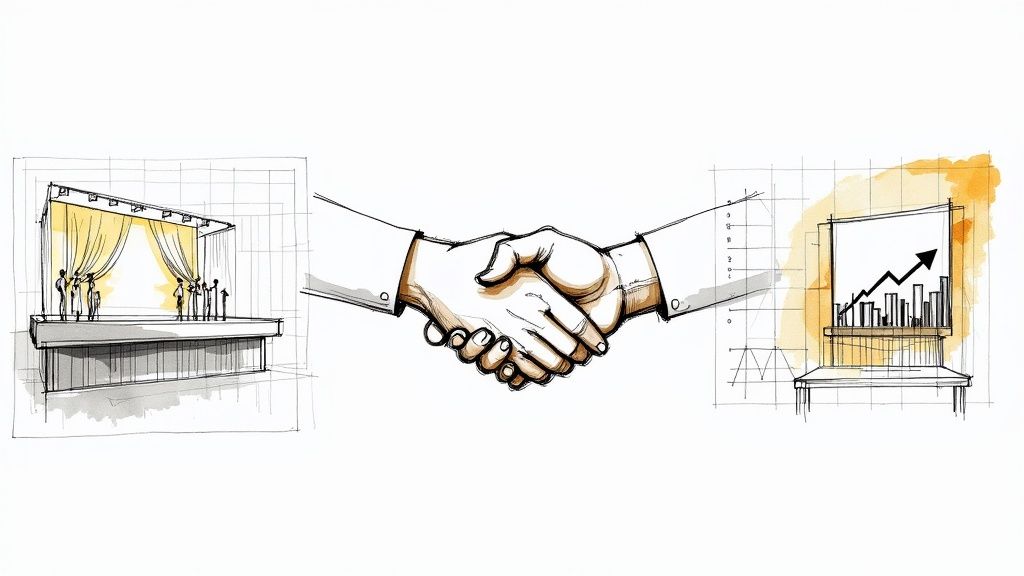
Before you even think about writing a sponsorship proposal, you need to do the foundational work. This is the stuff that separates the amateurs from the pros. It's about building such a compelling case for your event that the right brands see it as an unmissable marketing investment, not just another line item in their budget.
Landing a major sponsor doesn’t start with a flashy email or a cold call. The real work happens long before you reach out. This is where you dig in and build an evidence-based case that makes a "yes" from sponsors feel like the only logical answer. When you get this part right, your event’s value speaks for itself.
Success isn't about having the biggest audience; it's about having the right audience and being able to prove it. Generic stats like age and location are table stakes. Sponsors want to see that you understand their ideal customers on a deeper level.
So, who really comes to your event? You need to paint a vivid picture. I recommend creating 2-3 detailed audience personas that bring your typical attendees to life.
When a potential sponsor reads these, they should immediately see their target customer in your crowd. It makes the partnership feel like a natural fit. To get even sharper with your targeting, it’s worth diving into some modern B2B prospecting techniques.
Your Unique Value Proposition (UVP) is the heart of your pitch. It’s the story you tell that explains why your event exists and what makes it a can't-miss opportunity, separating you from every other event asking for sponsorship dollars. A strong UVP is specific, memorable, and speaks directly to what a sponsor gets out of the deal.
Key Takeaway: Your UVP isn't just a description of your event. It's about the exclusive access, community, and marketing environment you provide. You need to frame it as the solution to a sponsor's specific marketing challenges.
For instance, don't just say, "We're a tech conference." Instead, try something like: "We are the only regional summit that brings 500+ pre-qualified enterprise tech buyers and key decision-makers together for a day of intensive, solutions-focused networking." See the difference?
Finally, it's time for a reality check. You need to create a complete inventory of every single asset you can offer a sponsor, both tangible and intangible. This list is absolutely critical for building your sponsorship packages later and for justifying every dollar you ask for.
Your audit should cover everything:
This internal audit is the backbone of your entire sponsorship strategy. It’s also a key part of your financial planning, which you can learn more about in our guide on budgeting an event.
The graphic below really brings this foundational process together, showing how it all flows from understanding your audience to auditing your assets.
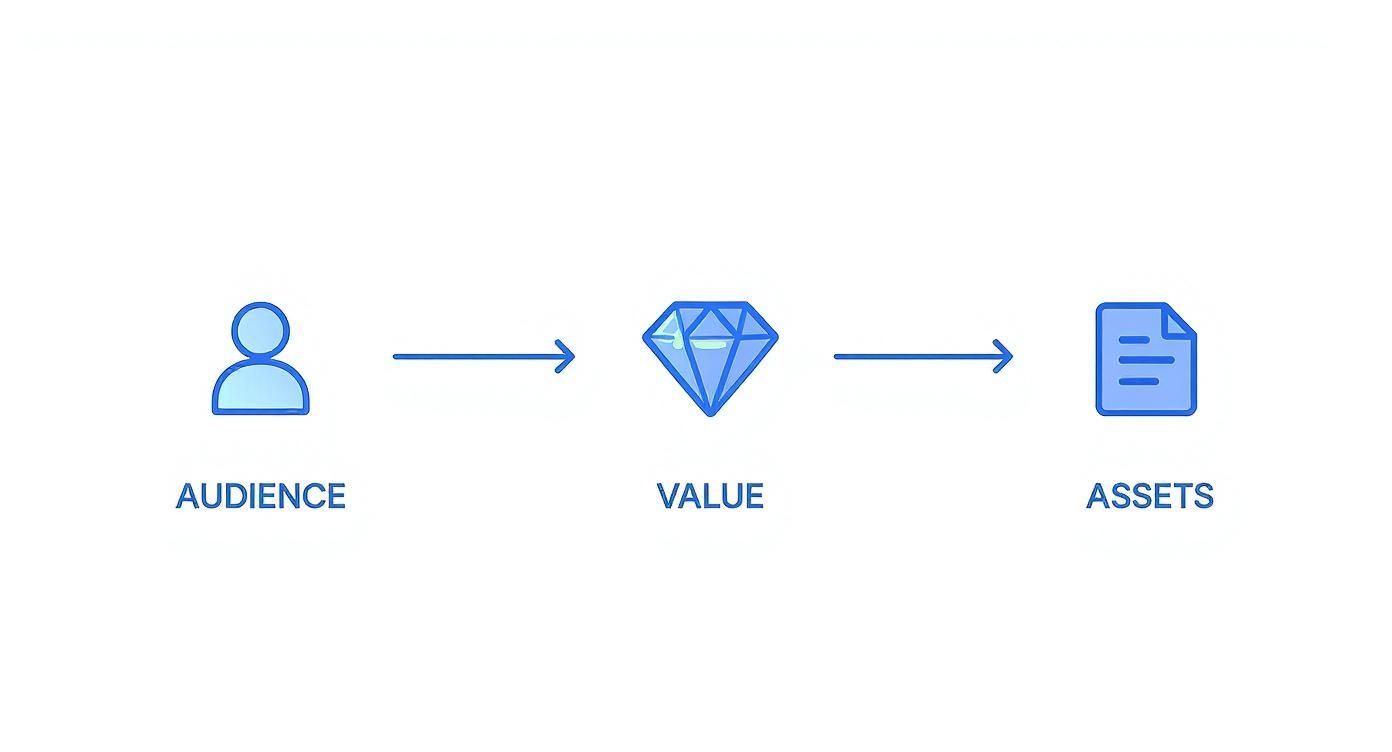
As you can see, a deep understanding of your audience is the launchpad for everything else. It defines your value and helps you identify the assets that sponsors will actually pay for. The good news is that the industry trends are on your side. The global events industry was valued at around $736.8 billion in 2021 and is projected to skyrocket to $2.5 trillion by 2035.
Plus, with 74% of event marketers expecting their budgets to increase in 2025 and two-thirds of attendees saying they feel more positive about a brand after an event interaction, your pitch for sponsorship is stronger than ever.
Let's be honest: the old "Gold, Silver, Bronze" package model is getting tired. Today's sponsors are smart. They aren't just donating to your event; they're making a strategic marketing investment and expect to see a real return. To get them to sign on the dotted line, you have to think like them. Your job is to create packages that solve their biggest problems, whether that's boosting brand awareness, generating qualified leads, or establishing themselves as an industry authority.
Forget the one-size-fits-all approach. Think of your sponsorship packages as your core product. They need to be well-designed, compelling, and irresistible. Each tier should tell a clear story of increasing value, making it obvious for a potential sponsor to see where they fit and why they might want to level up.
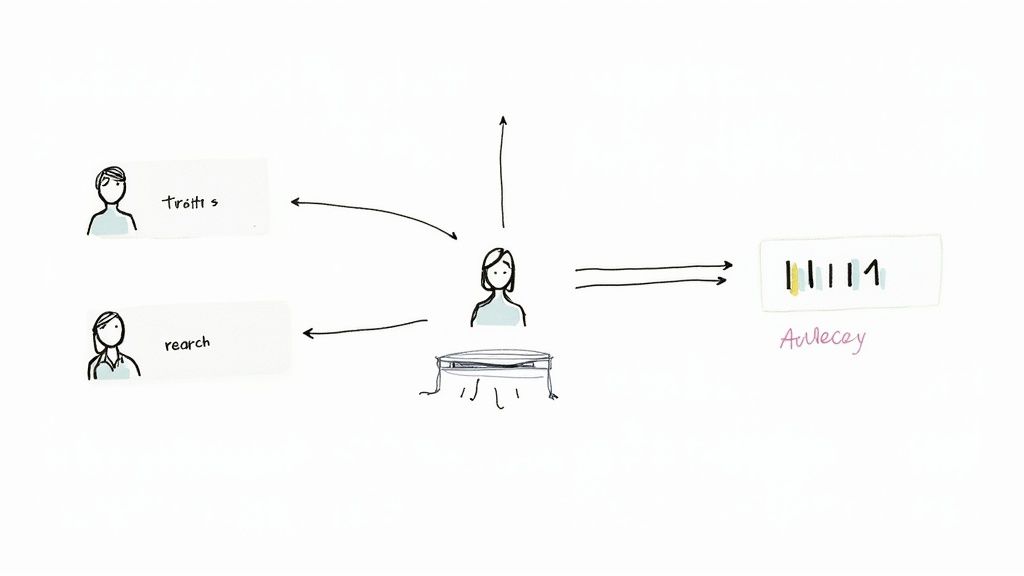
This is a perfect example of a high-value deliverable. The screenshot above from GroupOS shows how you can offer sponsors their own profile and asset management within your event platform. This isn't just a logo on a website; it's an integrated and powerful selling point that gives sponsors a direct line to your audience before, during, and after the event.
The foundation of a strong sponsorship strategy is a set of tiered packages that show a clear progression of benefits. I always think of it as a ladder—each rung you climb offers more access, more visibility, and deeper integration into the event experience. You want to make the jump to the next tier feel like a no-brainer.
Here’s a practical structure I’ve seen work time and time again:
To give you a better idea of how this looks in practice, here's a sample breakdown.
This table is just a starting point, of course. The key is to show a logical and valuable step-up at each price point. For a much deeper dive, check out our complete guide on building compelling event sponsorship packages. It’s filled with more examples to get your own creative ideas flowing.
Key Insight: Don't price your packages based on your costs. Price them based on the value you deliver. Consider the reach of your audience, the quality of your attendee demographics, the lead generation potential, and the exclusivity of what you're offering.
While tiered packages give you a great foundation, I've learned that flexibility is what often closes the deal. Many companies have very specific marketing goals that don't fit neatly into a pre-defined package. This is where offering 'a la carte' or add-on options becomes your secret weapon.
By allowing for customization, you shift the conversation from "Do any of these packages work for you?" to "How can we build the perfect package for you?" You become a strategic partner, not just a vendor selling a spot.
Here are a few high-demand a la carte items you can offer:
This isn’t just a gut feeling; the data backs it up. Recent trends show that 52% of companies actually prefer a la carte options over traditional bundled deals. What’s more, sponsors are increasingly looking for partnerships with a social impact component—engagement levels have been shown to be 33% higher for sponsorships aligned with a social cause. By offering flexible, creative, and meaningful opportunities, you’re not just meeting market demand, you’re making it much easier for sponsors to say "yes."
A brilliant proposal is useless if it lands in the wrong inbox or fails to tell a compelling story. You've done the hard work of designing valuable packages, but now comes the real test: mastering your outreach and pitch. This is where strategy, a personal touch, and a sharp presentation all come together to turn a cold lead into a warm conversation.
Successful outreach is all about smart prospecting. Just blasting a generic email to every business in town is a surefire way to get ignored. Your goal is to find companies whose brand values and target customers are a dead-on match for your event.
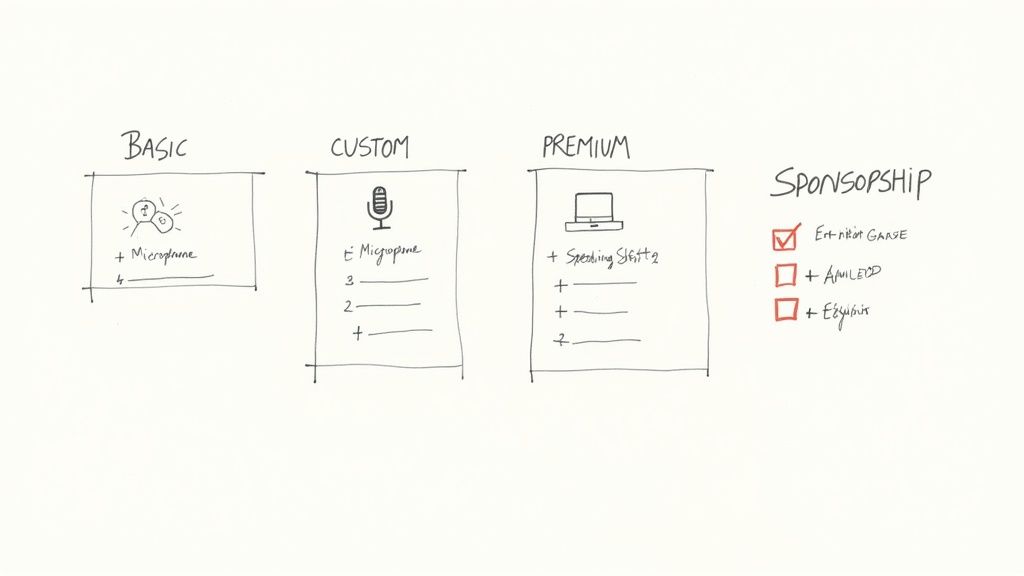
Think back to your audience personas. If "Startup Steve" is a core attendee, which companies are dying to sell to him? Those are your A-list prospects. Remember, the biggest thing you can offer a sponsor isn't just exposure to your audience—it's direct access to their ideal customer.
Once you have a solid list of prospects, you need to find the right person to talk to. Sending your pitch to a generic "info@" email is like dropping it into a black hole. You’re aiming for a specific person, usually in the marketing or partnerships department.
Keep an eye out for these titles:
LinkedIn is your best friend here. When you find the right contact, don’t just fire off a generic connection request. Engage with their content first. A thoughtful comment on a post they shared goes a long way. It warms them up to your name before your email ever hits their inbox.
Your first email needs to be short, personal, and focused on value. Long, rambling messages get deleted instantly. Keep it brief and laser-focused on what’s in it for them.
Pro Tip: Whatever you do, don't ask for money in your first email. The goal of that initial outreach isn't to close a deal; it's to book a meeting. You're just trying to spark enough interest to get them on a quick call where you can actually learn about their goals.
Once you've landed that meeting, your sponsorship deck (or proposal) becomes your most important tool. This isn't just a boring document with your logo and prices. It’s a visual story that sells the dream of your event and why they should be a part of it.
A powerful deck needs to do three things really, really well:
Think of your deck as the visual backdrop for your conversation. It should be clean, professional, and easy to skim. Use high-quality photos from past events, simple charts for your data, and don't be afraid of white space. A well-designed proposal screams professionalism and builds trust. For a detailed walkthrough and some great ideas, check out our guide on creating a sample sponsorship proposal.
Sponsors need data to justify their investment. This is critical. Make sure you include hard numbers like website analytics, social media reach, and email list subscribers to build a rock-solid case for the ROI they'll see. When you anchor your pitch in real data and a compelling vision, your ask transforms from a simple request into a strategic business opportunity they can’t afford to miss.
https://www.youtube.com/embed/vUCAs55jBrA
You’ve landed the meeting and presented a killer proposal. Now, the real conversation begins. The negotiation phase is where you turn a sponsor's interest into a solid commitment. This isn’t about winning an argument; it’s about finding that sweet spot where a true, mutually beneficial partnership can flourish.
Expect some pushback—it’s a natural part of any significant business deal. A sponsor questioning your price or asking tough questions about ROI isn't a red flag. In fact, it's a good sign. It means they're seriously considering your offer and just need to justify the investment internally. Your job is to listen, understand their concerns, and respond with confidence.
When a potential sponsor raises an objection, don’t get defensive. Think of it as an invitation to find a solution together. Most of the time, the conversation will circle back to two main hurdles: the budget and the value.
The Budget Objection ("It's too expensive"): Your first instinct might be to immediately slash the price, but hang on. A much better approach is to circle back to the value you're offering. Ask clarifying questions like, "Which parts of the package feel misaligned with your budget?" This helps you pinpoint whether the entire price is the problem or just certain elements they don't see value in.
The ROI Objection ("How can you guarantee a return?"): No one can guarantee ROI, and you shouldn't try. Instead, you can demonstrate the potential. This is where you bring out your data from past events—attendee demographics, lead generation stats, and glowing testimonials from previous sponsors. You're not selling a cost; you're offering them direct, curated access to their ideal customer.
Key Takeaway: Negotiation is all about flexibility, not just dropping your price. A "no" to your top-tier package could easily become a "yes" to a custom-built solution. The goal here is to build a partnership, not just process a transaction.
Knowing when to hold your ground on pricing versus offering alternatives is more of an art than a science. If a sponsor is trying to get your premium package benefits for an entry-level price, it’s usually best to politely stand firm. Giving away your best assets on the cheap devalues them for everyone else.
But what if a sponsor has a genuine budget limitation but is a perfect fit for your event? This is your chance to get creative. Solving their problem builds incredible goodwill and can lock in a valuable partner for years to come.
Try thinking outside the cash-only box:
The sponsorship world is booming, which gives you more leverage than you might realize. For example, the global sports sponsorship market was valued at USD 60.17 billion in 2024 and is projected to hit USD 132.86 billion by 2033. This massive growth shows that brands are hungry for event partnerships that deliver. You can read more about this remarkable growth in sports sponsorship markets to get a sense of the bigger picture.
Once you’ve got a verbal agreement, it’s time to make it official. A professional, clear sponsorship contract is non-negotiable. It’s what protects both you and your sponsor by setting clear expectations and preventing headaches down the road.
A handshake deal is a recipe for disaster. Your agreement needs to be comprehensive and easy to understand.
Your contract absolutely must include these key pieces:
A solid contract doesn't create friction; it builds the foundation of trust needed for a successful and, hopefully, long-lasting partnership.
Getting that check is a huge milestone, but the real work starts now. The moment a sponsor signs on the dotted line, you're on the clock to prove their investment was a smart one. Delivering on your promises is what turns a one-time sponsor into a long-term partner who can't wait to sign up again next year.
This is all about flawless execution. You absolutely need a system to make sure not a single deliverable falls through the cracks. Forgetting a pre-event social media post or misplacing a banner on-site can sour a relationship you worked so hard to build.
Before the beautiful chaos of the event kicks off, put together a detailed sponsor activation checklist for each partner. This is more than just a to-do list; it’s your operational bible for keeping sponsors happy. Treat it like a real project plan—assign owners and deadlines to every single item.
I like to break my checklists down by timeline:
This level of organization does more than just prevent mistakes. It signals a level of professionalism that sponsors really notice and appreciate.
Don't ever make your sponsors ask for updates. Keep up a steady drumbeat of proactive communication that makes them feel like valued insiders, not just walking logos. A simple weekly check-in email leading up to the event can make a world of difference.
Let them know when their social media feature is scheduled to go live. Send them a sneak peek of the event signage with their logo on it. These small gestures build tremendous goodwill and show you’re on top of every detail. During the event itself, make sure they have a dedicated point person—someone they can find in a heartbeat to ask questions or get help.
Your sponsors are your partners, not your patrons. The more you treat them with the respect and attention of a true collaborator, the more invested they will become in your event's success and your future relationship.
After the last attendee has gone home, your most important job begins: proving the return on investment (ROI). A comprehensive, data-rich post-event report is the single most powerful tool you have for securing a renewal. This report is your hard evidence, showing the tangible value you delivered.
To really understand what premium brands are looking for, it's worth reading up on how luxury event sponsorship can drive significant returns. This context can help you frame your report around the metrics that truly matter.
Your report has to be more than a fancy "thank you." It needs to be packed with concrete numbers that tie directly back to the goals you discussed during negotiations.
Here’s what to include:
Present this data in a clean, visually appealing way. Use charts and graphs to make the numbers pop and easy to understand. You can learn more about which KPIs to focus on by exploring our complete guide on measuring event ROI.
This final report is your closing argument for next year. When you clearly demonstrate the value they received, you make the decision to re-invest an easy one. You’re not just asking them to sponsor again; you're showing them why they can't afford to miss it.
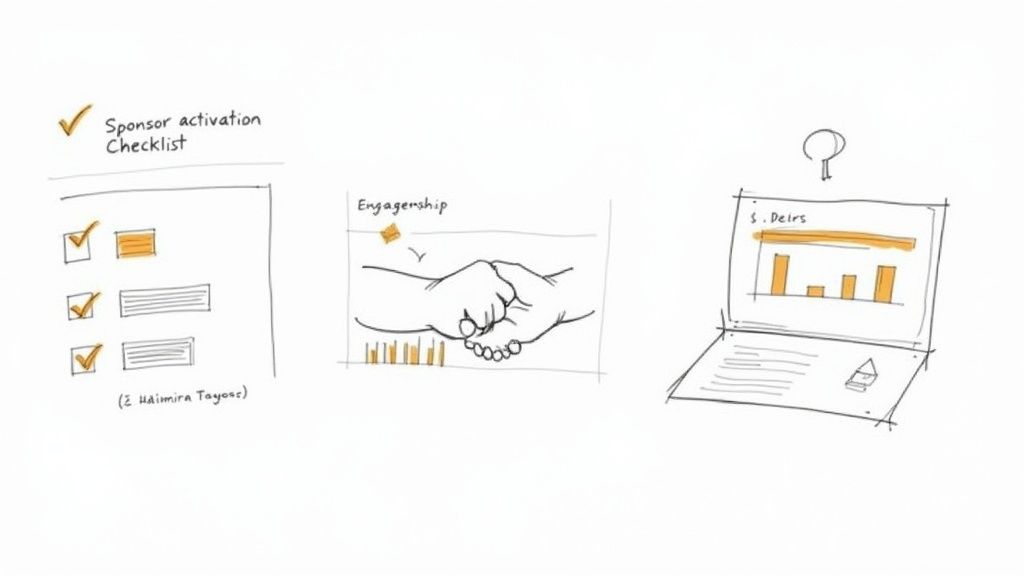
Diving into sponsorship can bring up a lot of questions, especially when you're trying to get it right. You're not alone. Let's tackle some of the most common hurdles event organizers face when trying to lock down sponsors.
This is a big one, and the answer really depends on the scale of your event. If you're planning a major conference or an annual summit, you need to start the hunt 6-12 months out. Why so early? Because large companies lock in their marketing budgets way ahead of time, usually in Q3 or Q4 for the following year. Getting on their radar early means you're part of their planning, not an afterthought.
For smaller, local, or regional events, you can work with a shorter runway. A 3-6 month window is usually plenty of time. This gives you enough breathing room to pitch, negotiate, sign contracts, and even start rolling out some pre-event promotional perks for your new partners without scrambling at the last minute.
First, don't take it personally. A "no" is just part of the game, and it rarely means "never." The most important thing is to respond with class. A simple thank you for their time and consideration goes a long way.
But don't stop there. Turn that rejection into intel. You can politely ask for feedback. Try something like, "I really appreciate you getting back to me. To help us improve, would you mind sharing what wasn't quite the right fit for your goals right now?" The insights you get are gold for refining your pitch. And always ask to keep them in the loop for future events—you're leaving the door cracked open for next time.
They absolutely can be, but you have to be smart about it. An in-kind sponsorship is simply when a company provides goods or services instead of cash. This could be anything from AV equipment and marketing muscle to free food and drinks for your attendees. These deals can slash your event budget, which is just as good as cash in the bank.
The trick is to assign a realistic market value to whatever they're offering. If a production company provides $5,000 worth of gear that you would've had to rent anyway, that’s a $5,000 sponsorship. Treat it that way. This ensures they get placed in the right sponsorship tier with benefits that match their contribution.
Don't just fire your proposal into the void of a generic "info@" email address. That's a surefire way to get ignored. You need to find the actual decision-maker, and your best friend here is LinkedIn.
Look for people with titles that scream "sponsorship." Think:
Once you've zeroed in on a few promising contacts, do your homework. A little personalization makes all the difference. Mention a recent company win, a campaign you admired, or a mutual connection in your outreach. It shows you're not just spamming a list and dramatically increases your chances of getting a reply.
Keeping track of every conversation, contract, and deliverable can feel like a full-time job in itself. GroupOS pulls it all together, giving you one central place to manage sponsor profiles, track your pipeline, and prove their ROI to attendees. It makes securing and keeping great partners so much easier. Start your free trial with GroupOS today.


